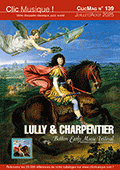 1705 : Reinhard Keiser écrit ce qu’on peut considérer comme le premier Passion-oratorio de l’histoire. 2006 : Christine Blanken (qui nous gratifie d’une notice remarquablement informative) redécouvre la partition et en prépare une édition exécutable. 2010 : l’oratorio est redonné pour la première fois à Wandersleben, ville natale du librettiste Hunold. Par qui ? Les mêmes qui l’enregistrent en 2018 à l’occasion de la Bachfest de Leipzig, et que voici. La distribution vocale de 2010 a légèrement changé, tous les solistes étant cette fois tirés du chœur à l’exception du Jésus de Dominik Wörner. On comprend vite à quel point la version de 1705 a pu susciter la controverse : le texte ne cite pas textuellement les évangiles mais réécrit l’histoire avec des mots de tous les jours, insérés de plus dans nombre d’arie da capo… alors, opéra (interdit pendant le carême) ou non ? Keiser, maître des opéra, pouvait facilement être suspect ! Il s’en tira en intégrant plus tard des fragments de textes ou de chorals connus de tous… c’est la version qu’on entend ici. Bien sûr ce premier oratorio du genre n’a pas la richesse et les fulgurances musicales de ses successeurs, et il s’étire sur 2 heures. Mais quelle maîtrise de la composition, quelle humanité des personnages ! Quant aux interprètes, totalement investis, qui pourrait être plus familier qu’eux de cette œuvre qu’ils ont ressuscitée ? Rien que pour cela, exceptionnel assurément. (Olivier Eterradossi)  Reinhard Keiser’s Der blutige und sterbende Jesus is not only the very first German Passion oratorio but also a highly suspenseful contribution to the Passion season. Lost for many years, it is now available for listening on CD in the revised version of 1729. The dramatic and musical design of Keiser’s work is astonishing. As in the Italian oratorio type that gained currency after 1700, there is no Evangelist or other narrator, which means that the work has a purely dramatic structure. Even though Keiser’s librettist Christian Friedrich Hunold, whose pseudonym was »Menantes,« did not cite any one of the four Evangelists word for word in his adaptation of the Passion narrative, it is quite evident that the poetic elaboration is (primarily) modeled on Luther’s translation of the Gospel of Matthew. As might be expected, Hunold and Keiser based their work on the dramatic means of the opera typical of their times while working on the one hand with contrasts between short, often homophonic five-part choirs of the two different groups of participants and on the other hand with multipart, interior monologues by the main characters. The great number of very highly expressive arias and ariosi, each of which has its own very special character, produced a tightly woven fabric that, far from the traditional Kantorei tradition, forms a link to the modern music of its times. Keiser’s oft-praised instrumentation artistry is shown here in his innovative, effectively and enthrallingly varied tone-color combinations in the orchestra. His talent for the clear delineation of a musical scenario with only a single accompaniment voice is legendary.
 |
